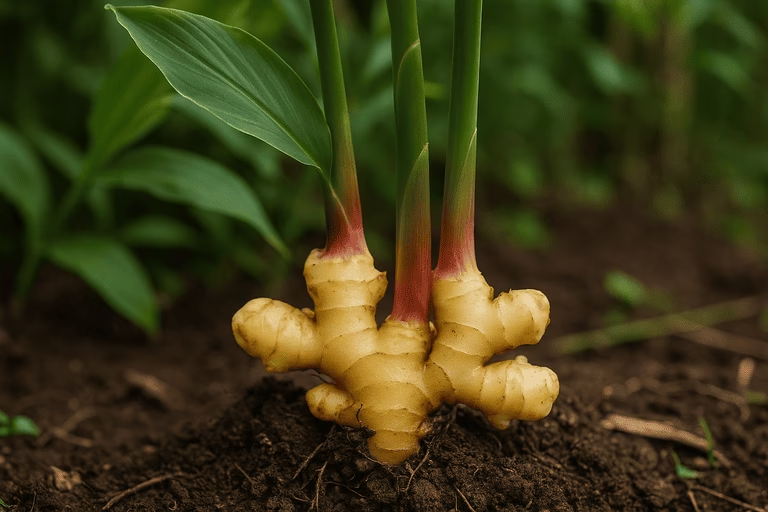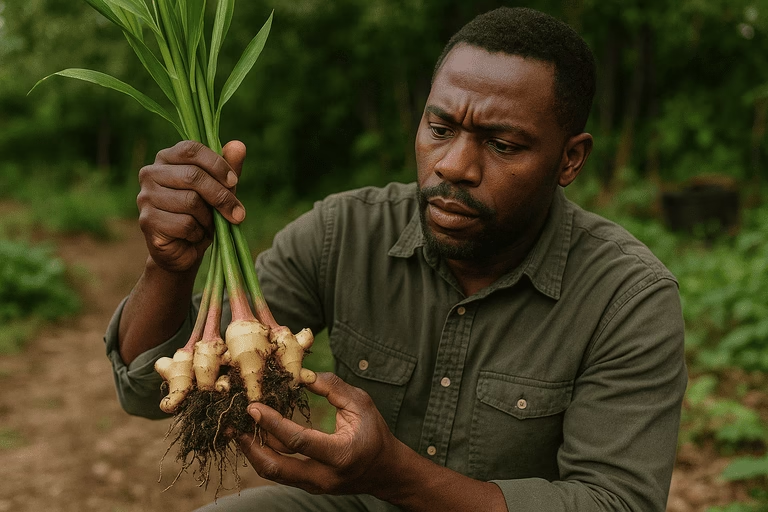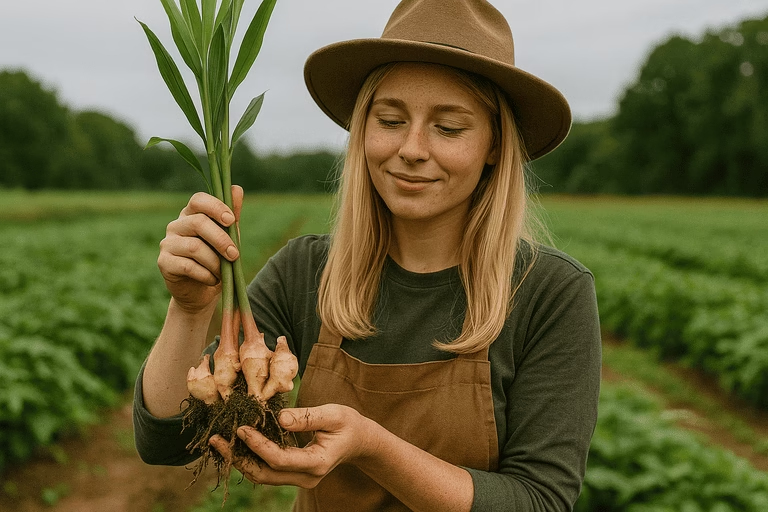In survival situations, few plants offer as much value as edible ginger plants. Known for their distinct aroma, spicy flavor, and medicinal properties, they’re more than just a kitchen staple—they’re a trusted natural remedy and food source in many cultures around the world. Whether you’re foraging in the wild or growing your own provisions, ginger provides critical nutrients, warmth, and immune support.
Unlike many wild plants, ginger is relatively easy to identify and process. It can be eaten raw, brewed into tea, or dried for long-term storage. In addition, it plays a vital role in digestive health, helping your body process less familiar or heavier wild foods. For those living off-grid or practicing bushcraft, understanding how to locate, identify, and use ginger is a practical survival skill that yields both flavor and function.
How to Identify and Harvest Edible Ginger Plants in the Wild
Knowing how to correctly identify edible ginger plants can significantly improve your foraging success. The most well-known type is Zingiber officinale, but other edible varieties include Zingiber zerumbet (shampoo ginger) and Alpinia galanga (galangal). Most of these plants prefer tropical or subtropical environments with rich, moist soil and dappled sunlight.
Look for narrow, lance-shaped leaves that grow in pairs along tall green stalks. The underground rhizome is the part you’re after—it’s knobby, pale, and aromatic when broken open. Foraging ginger usually involves digging carefully to avoid damaging the rhizomes. In addition, make sure you’re not mistaking it for similar-looking but toxic species like wild turmeric or inedible ornamental gingers. Using a field guide or cross-referencing with multiple sources is crucial when foraging in unknown terrain.
Edible Hibiscus Plants: A Forager’s Guide
Once harvested, rinse the root gently to remove soil and debris. Use what you need fresh, and dry or freeze the rest. Ginger stores exceptionally well when handled properly, making it a reliable long-term resource in any survival setting.

Culinary Uses of Edible Ginger Plants in the Wild
Ginger isn’t just medicinal—it’s also a flavorful ingredient that transforms bland wild meals into something energizing and comforting. In a survival context, edible ginger plants can be used in numerous ways. For instance, you can slice it into boiling water for a warming tea that aids digestion and helps fight nausea. This is especially helpful when adjusting to an unfamiliar wild diet.
In addition, grated ginger can be added to wild greens, root stews, or even roasted meats (if available) to enhance flavor and reduce the heaviness of certain foods. Ginger’s natural heat also helps warm the body in cold environments, acting almost like an internal fire. The fibrous nature of the root means it should be cut thinly or cooked well for easier digestion.
Therefore, even small amounts of ginger can elevate your outdoor meals while supporting your overall health. It’s the perfect blend of culinary and medicinal value—something few wild edibles can offer simultaneously.
Medicinal Benefits of Edible Ginger Plants in Survival Situations
Beyond taste, edible ginger plants are prized for their powerful medicinal properties. Ginger contains compounds like gingerol and shogaol, which have been shown to reduce inflammation, soothe sore muscles, and fight infections. For example, chewing a slice of raw ginger can ease sore throats, relieve motion sickness, or calm an upset stomach.
In survival scenarios, where access to traditional medicine may be limited, natural remedies become essential. A strong ginger tea can break fevers, improve circulation, and support your immune response against cold or flu symptoms. In addition, ginger’s antibacterial properties make it useful for minor wound care or internal detoxification when resources are scarce.
Edible Lavender Plants for Culinary Delights
Incorporating ginger into your foraging and survival strategy isn’t just helpful—it can be life-saving in the right situation. Therefore, understanding its benefits and learning how to prepare it safely should be part of any serious wilderness skillset.
Growing Edible Ginger Plants for Long-Term Resilience
For those with the ability to grow their own food, cultivating edible ginger plants offers an excellent long-term strategy. Ginger can be grown from small sections of rhizome that contain at least one eye or bud. Plant it in well-drained, fertile soil and keep it moist but not waterlogged. Within a few weeks, shoots will appear, and by late summer or early fall, you’ll have a usable harvest.
In addition, ginger is relatively pest-resistant and can be grown in containers or small garden plots, making it suitable even for compact homesteads or temporary survival shelters. It doesn’t require much attention but provides incredible returns in terms of nutrition and utility. Over time, one plant can produce several rhizomes, allowing you to replant and sustain a continuous supply.
By integrating ginger into your permaculture system or food forest, you’re investing in a powerful, renewable source of medicine and flavor. And since fresh ginger often fetches high prices in markets, it can also be bartered or traded in survival communities.

Safety Precautions When Using Wild Roots
Harvesting wild roots comes with responsibilities. Some edible roots can look similar to toxic species, and mistakes can be dangerous. Therefore, always double-check plant characteristics—leaf shape, growth pattern, aroma, and habitat—before harvesting or consuming any root. For ginger, the strong, unmistakable scent is a major identifier, but visual similarities with other plants still require caution.
In addition, avoid foraging near roadsides, industrial sites, or areas that may be contaminated with chemicals or pollutants. Roots absorb toxins from the soil, and consuming them could harm your health. Wash your harvest thoroughly and inspect each piece before storing or cooking. When dealing with edible ginger plants, cleanliness and identification are just as important as the harvest itself.
Pairing Ginger with Other Wild Ingredients
One of the great joys of wilderness cooking is the creativity it demands. Ginger’s bold, spicy flavor pairs beautifully with a wide variety of wild ingredients. For instance, mix it with wild greens like nettles or dandelion to balance bitterness with warmth. You can also combine ginger with wild berries to create a tangy compote over a fire, or steep it with pine needles for a vitamin C-rich immunity boost.
In addition, try simmering ginger with wild garlic in broths foraged from bone or root bases. These combinations not only elevate the flavor of your meals but also increase their nutritional complexity. Blending edible ginger plants with other wild edibles teaches you how to use ingredients harmoniously—and stretches your resources further.
Preserving Ginger for Long-Term Use
In any survival situation, food preservation is key. Ginger offers multiple storage options. First, you can slice and dehydrate it, preserving both flavor and medicinal potency for months. Dried ginger is lightweight, compact, and ideal for packing in your survival bag. In addition, you can pickle ginger in vinegar with salt, creating a tangy, shelf-stable ingredient that adds both flavor and probiotics to your diet.
Bushcraft Survival Kit: Must-Have Items for Safety
Another option is freezing. If you’re at a base camp or homestead with limited refrigeration, burying ginger in cool, dry soil or placing it in a root cellar can also work. The goal is to maintain its moisture without encouraging mold. Whatever method you choose, preserved ginger is a valuable, long-term asset in your survival pantry. With edible ginger plants, you’re never far from a powerful food-medicine hybrid that stores as well as it performs fresh.
Teaching Others and Passing on Knowledge
Sharing knowledge about wild edibles strengthens community and preserves tradition. Teaching friends or younger family members how to identify, harvest, and use ginger not only increases collective resilience—it builds deeper respect for nature. Start by introducing them to the scent and shape of the rhizome. Then, show them how to prepare simple teas or spice up foraged meals.
In addition, use storytelling. Many cultures pass down herbal knowledge through oral tradition, blending it with history, myth, and memory. Ginger has a rich history across the globe, and integrating those stories can make the learning process more meaningful. The more people understand edible ginger plants, the more secure and empowered they become in nature.

Quick Recap
Let’s review the core insights we’ve explored in this comprehensive guide to edible ginger plants, tailored for wild living and survival readiness.
We started by discussing why ginger is a top-tier wild plant for survivalists: it provides nutrition, warmth, and powerful medicinal benefits. Then, we walked through the process of identifying edible ginger species in the wild, such as Zingiber officinale and Zingiber zerumbet. You learned how to harvest the rhizomes safely and prepare them for immediate use or storage.
We explored how to incorporate ginger into wilderness meals—through teas, broths, and cooked dishes—and detailed its therapeutic value, from soothing upset stomachs to fighting infections. Growing ginger at home was also discussed, emphasizing its role in long-term resilience and off-grid sustainability.
Additionally, we highlighted important safety practices when handling wild roots, creative ingredient pairings, and multiple preservation methods. Lastly, we emphasized the importance of passing this knowledge on, ensuring future generations remain connected to their landscape and food sources.
Altogether, edible ginger plants serve as a cornerstone for anyone serious about survival, herbalism, or wild food culture. From the forest floor to your foraged campfire stew, ginger is more than a plant—it’s a lifeline.

